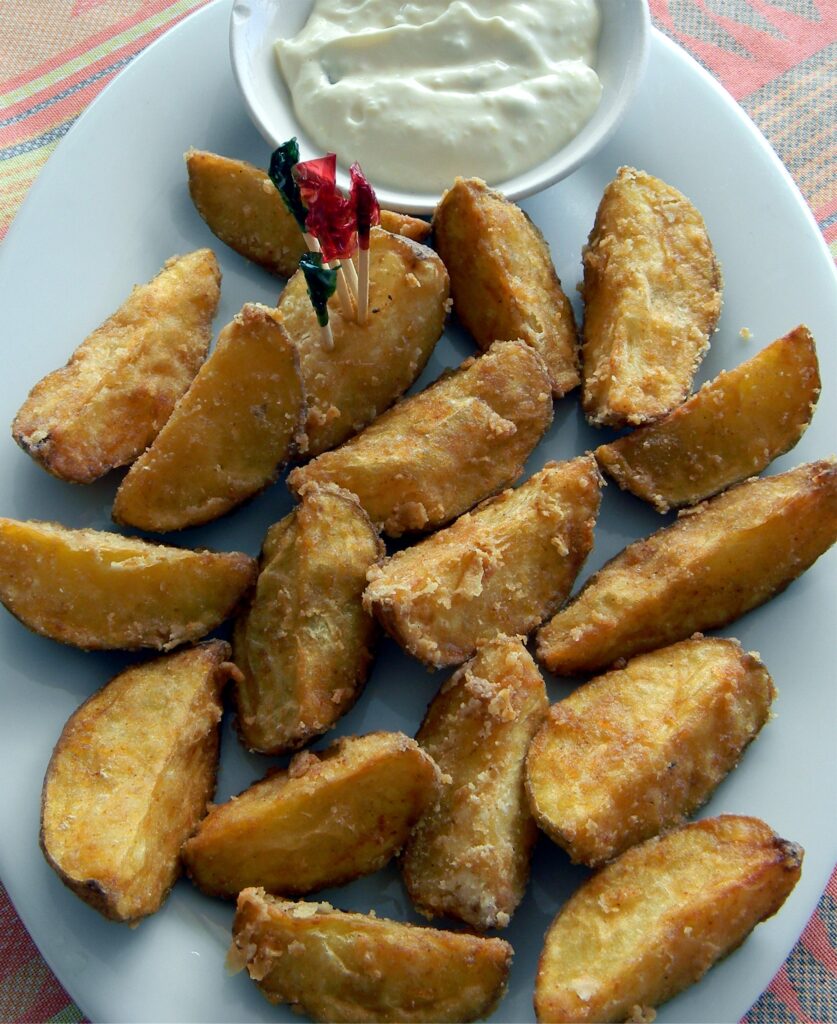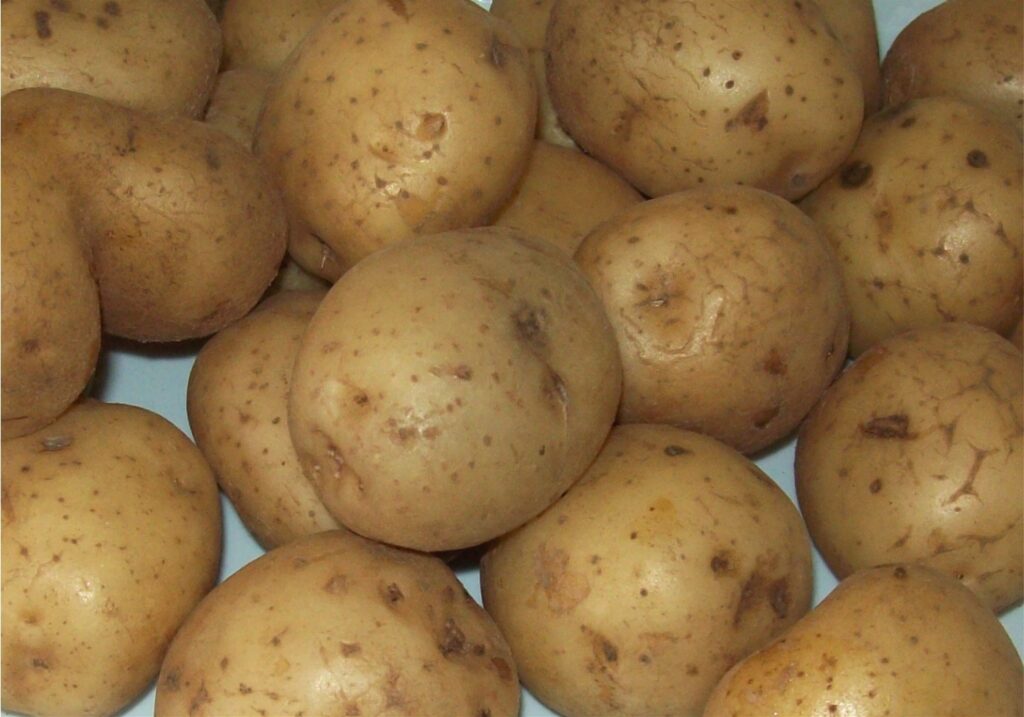Text and Photo by Henrylito D. Tacio
Potatoes may be known as “poor man’s food,” but their nutritional values can most certainly make any poor man rich – in health, that is.
Currently, potato is the fourth largest source of food in the world – after rice, wheat, and corn. Every year, 350 million tons of potatoes are produced, 52 percent of these in developing countries.
Freshly harvested, potato contains about 80 percent water and 20 percent dry matter. About 60 to 80 percent of the dry matter is starch. On a dry-weight basis, the protein content of potatoes is similar to that of cereals and is very high in comparison with other roots and tubers.
“The potato contains high quality protein and substantial amounts of essential vitamins, minerals, and trace elements,” says Potatoes for the Developing World, published by the International Potato Center (CIP). “Raw cereals and beans yield substantially more energy than potatoes, but the difference is much less if comparisons are made on a cooked basis.”
The protein content of potatoes is equal to yam and is almost twice that of sweet potato and cassava. Moreover, on a cooked basis, the potato compares with other major staples, such as boiled rice and cereals cooked as porridges.
“The average amount of potato protein required for maintenance of nitrogen balance in adults is similar to the amount in an egg, and is less than that required in many other foods including beef, tuna fish, wheat flour, soybean, rice, corn, and beans,” the CIP book notes. “If a whole egg has a protein score of 100, potatoes have a score of 70. This compares with 75 for sweet potatoes and rice and scores of 40 to 60 for wheat, corn, beans, and peas.”

Potato 
Potato
The potato has a well-balanced protein-to-calorie ratio. “If you eat enough potato to supply a significant amount of energy,” the CIP book claims, “a significant quantity of protein will also be provided.”
“Potatoes are rich in several micronutrients, especially vitamin C – eaten with its skin, a single medium-sized potato of 150 grams provides nearly half the daily adult requirement (100 milligrams),” says the United Nations Food and Agriculture Organization (FAO).
History records showed that during the Alaskan Klondike gold rush (1897-1898), potatoes were practically worth their weight in gold. Potatoes were so valued for their vitamin C content that miners traded gold for potatoes.
Not only that, the potato is a moderate source of iron, and its high vitamin C content promotes iron absorption. It is a good source of vitamins B1, B3, and B6 and minerals such as potassium, phosphorus, and magnesium, and it contains folate, pantothenic acid, and riboflavin. Potatoes also contain dietary antioxidants, which may play a part in preventing diseases related to aging, and dietary fiber, which benefits health.
Basically, potatoes are fat-free, cholesterol-free, and low in calories, according to the Food and Nutrition Research Institute of the Department of Science and Technology.
However, the nutritional value of a meal containing potatoes depends on other components served with them and on the method of preparation. “By itself, potato is not fattening (and the feeling of satiety that comes from eating potato can actually help people to control their weight),” the UN agency explains.
However, preparing and serving potatoes with high-fat ingredients raises the caloric value of the dish. “Since the starch in raw potato cannot be digested by humans, they are prepared for consumption by boiling (with or without the skin), baking or frying,” FAO points out.
Here’s something for the trivia buffs. When Scotch-Irish immigrants started to settle in Maine in 1791, they brought potatoes along into what was to become one of the United States. However, it was American president Thomas Jefferson who introduced pomme frites to his people after his return from a trip to Paris. Now, as American as apple pie, they are promoted as “American fries” at MacDonald’s and similar eateries in other parts of the world. (But in the Philippines, they are still called “French fries.”)
In 1853, railroad magnate Commodore Cornelius Vanderbilt complained that his potatoes were cut too thick and sent them back to the kitchen at a fashionable resort in Saratoga Springs, NY. To spite his haughty guest, Chef George Crum sliced some potatoes paper-thin, fried them in hot oil, salted, and served them. To everyone’s surprise, Vanderbilt loved his “Saratoga Crunch Chips,” and potato chips have been popular ever since.
But there’s more to the potato than French fries and potato chips. In the past, the potato has been considered a medicinal plant. To carry a raw potato in the pocket was an old-fashioned remedy against rheumatism that modern research has proved to have a scientific basis.
Ladies in the olden times had unique bags or pockets made in their dresses in which to carry one or more small raw potatoes to avoid rheumatism. Successful experiments in the treatment of rheumatism and gout have in the last few years been made with preparations of raw potato juice.
In cases of gout, rheumatism, and lumbago, the acute pain is much relieved by fomentations of the prepared juice followed by an application of liniment and ointment. Sprains and bruises have also been successfully treated by the potato-juice preparations.
Hot potato water has in years past been a remedy for some forms of rheumatism. A popular potato remedy for rheumatism was made by cutting up the tubers, infusing them together with the fresh stalks and unripe berries for some hours in cold water, and applying in the form of a cold compress. The potatoes were not peeled.
Meanwhile, starch from potato is also widely used by the pharmaceutical, textile, wood, and paper industries as an adhesive, binder, texture agent, filler, and oil drilling firm to wash boreholes. Potato starch is a 100% biodegradable substitute for polystyrene and other plastics and is used, for example, in disposable plates, dishes and knives.
Indeed, potatoes have come a long, long way. The name “potato” is believed to be derived from the Inca name papa. The association with Ireland is thought to be responsible for the name “Irish potato,” which is retained even though potatoes are grown almost all over the world.
But how potatoes became one of the most important foods is still a mystery to some people. In Seed to Civilization: The Story of Man’s Food, author C.B. Heiser, Jr. shares some information: “The story begins in South America. Wild potatoes are fairly widespread in the Americas, particularly in the Andes. They were probably found to be valuable food when man first entered this area, and at some undetermined time, probably more than 4000 years ago, they came to be intentionally cultivated. With selection by man, there was an increase in size, and the potato became the most important food plant in the high Andes, for it thrives at an elevation where few other cultivated plants will grow. Corn will not grow at elevations much higher than 11,000 feet and is not an incredibly productive plant at that altitude, but potatoes do well at 15,000 feet.
“Frost, common in parts of the Andes, is not conducive to keeping potatoes, but the Indians found how to make it an ally. Potatoes were allowed to freeze at night and the next day the Indians would stamp on the thawing potatoes. This process, repeated for several days, removes the water, resulting in a desiccated potato, called chuno, which may be kept almost indefinitely and used as required. Thus was born one of man’s original ‘freeze-dried’ foods, in a sense the forerunner of instant mashed potatoes but with a somewhat different taste. Although the flavor of chuno is not pleasing to all foreign visitors in the Andes, it is still the staff of life to many Indians in highland Peru and Bolivia. The potato was cultivated throughout the length of the Andes in prehistoric time, but it did not make its way to Central America until introduced by the Spanish.”
In 1536, Spanish Conquistadors conquered Peru, became aware of the potato, and carried them to Europe. Before the end of the sixteenth century, families of Basque sailors began to cultivate potatoes along the Biscay coast of northern Spain. In the Philippines, the potato was introduced when the Spaniards colonized the country.

